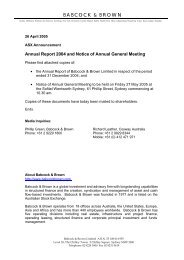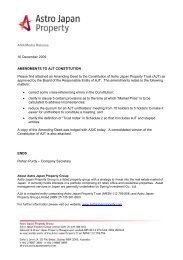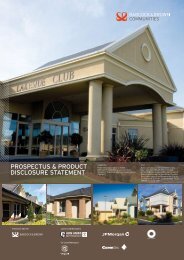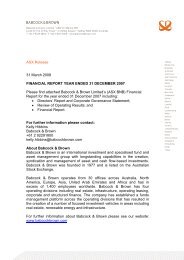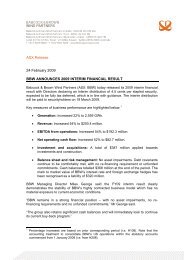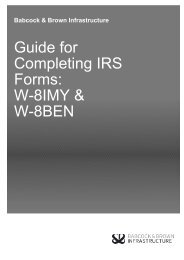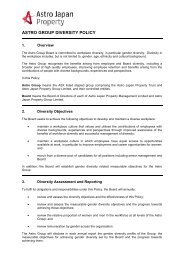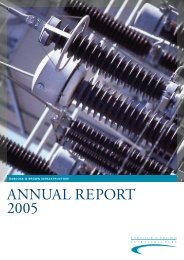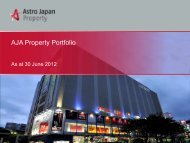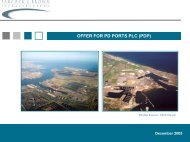Lead Manager
babcock & brown limited prospectus.pdf - Astrojapanproperty.com
babcock & brown limited prospectus.pdf - Astrojapanproperty.com
- No tags were found...
You also want an ePaper? Increase the reach of your titles
YUMPU automatically turns print PDFs into web optimized ePapers that Google loves.
BABCOCK & BROWN PROSPECTUS<br />
In analysing an investment or a new area of business activity, Babcock & Brown seeks to segment the risks<br />
involved and, where possible and cost-effective, to allocate these risks to the parties best able to manage them.<br />
For instance, the Group may contract with an experienced maintenance provider to ensure that an asset is well<br />
serviced rather than take the risk that higher than projected maintenance expenses could compromise the value<br />
or cash flows of an asset.<br />
4.9.5 Principal risks<br />
The principal risks that Babcock & Brown assumes in its activities include market, business, credit, regulatory,<br />
compliance, operational and reputational risks.<br />
4.9.5.1 Market risks<br />
Market risk refers to the potential for changes in the market value of the Group’s investment positions or revenue<br />
streams.There are various types of market risks including exposures associated with interest rates, equity market<br />
prices, currency rates and the general market values of asset classes in which the Group invests or which it manages.<br />
Interest rate risk<br />
Babcock & Brown finances the majority of its investments with significant amounts of debt. If the debt has a<br />
floating interest rate, an increase in interest rates could impact the value of an equity investment and also increase<br />
the cost of debt service.To reduce or eliminate this risk, the Group typically diversifies its business activities and<br />
investments and either employs fixed rate debt, or uses interest rate swaps and other hedging techniques to fix<br />
interest rates over the life of the investment.The Group is willing to forgo the potential economic benefit that<br />
could result in a falling interest rate environment to protect its downside risks and the predictability of cash flows<br />
from an asset by fixing rates.<br />
Equity market risk<br />
Babcock & Brown has investments in a number of listed securities and receives management and other fees that<br />
are directly or indirectly related to the equity market value of a security, either in absolute terms or relative to<br />
benchmark indices.These investments and fee streams could be adversely affected if general equity market values<br />
were to decline.The Group does not actively hedge its exposure to the risk of a general decline in equity market<br />
values, believing that such strategies are not cost-effective. Instead, the Group prefers to actively manage the<br />
underlying business or asset to ensure that its fundamental value is preserved. Many of the Group’s investments in<br />
listed securities are also in “event-driven” situations where value is more correlated with the outcome of a certain<br />
event or series of actions than with general equity market values.<br />
Currency risk<br />
The majority of Babcock & Brown’s revenue is derived in currencies other than the Australian dollar, and thus<br />
exposed to a decline in the values of those currencies relative to the Australian dollar. Since the majority of the<br />
Group’s expenses are denominated in the same currencies as the associated revenues, only the net income after<br />
total compensation is exposed to currency fluctuations. Babcock & Brown also expects to reinvest a significant<br />
portion of revenues in the jurisdictions in which the revenue is generated. Babcock & Brown therefore does<br />
not believe that it is cost-effective to hedge the Group’s revenue flows. Consistent with the focus on capital<br />
preservation, Babcock & Brown plans to use various hedging techniques to protect the value, in Australian dollar<br />
terms, of investments made in non-Australian markets.<br />
General market values of selected asset classes<br />
The value of Babcock & Brown’s investment positions and revenue streams may be adversely affected by the<br />
deterioration of the general market values of asset classes in which it invests, manages assets or conducts other<br />
activities. Examples of such asset classes include property, infrastructure, aircraft, railcars and semiconductor<br />
manufacturing equipment. As was the case for general equity market value risk, Babcock & Brown does not<br />
actively hedge its risk to general declines in the market values of such asset classes, preferring to actively manage<br />
the fundamental value of the asset and diversify its business mix and investment portfolio, although risk is often<br />
mitigated by the use of limited or non-recourse debt to finance investments as described in Section 4.9.4.<br />
4.9.5.2 Business risks<br />
As Babcock & Brown increasingly invests in operating businesses it exposes itself to general business risks<br />
associated with operating businesses. Employee issues, competitive pressures, economic and political conditions<br />
and cycles, as well as extraordinary event risks will all impact on these types of businesses.<br />
101



